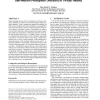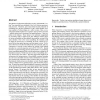5 search results - page 1 / 1 » Tuning Self-Motion Perception in Virtual Reality with Visual... |
TVCG
2012
11 years 7 months ago
2012
—Motion perception in immersive virtual environments significantly differs from the real world. For example, previous work has shown that users tend to underestimate travel dista...
VR
2002
IEEE
13 years 4 months ago
2002
IEEE
When people move there are many visual and non-visual cues that can inform them about their movement. Simulating self motion in a virtual-reality environment thus needs to take th...
VRST
2006
ACM
13 years 10 months ago
2006
ACM
Despite amazing advances in the visual quality of virtual environments, affordable-yet-effective self-motion simulation still poses a major challenge. Using a standard psychophysi...
APGV
2005
ACM
13 years 10 months ago
2005
ACM
The illusion of self-motion induced by moving visual stimuli (“vection”) has typically been attributed to low-level, bottom-up perceptual processes. Therefore, past research h...
ICAT
2003
IEEE
13 years 9 months ago
2003
IEEE
Virtual reality is often used to simulate environments in which the direction of up is not aligned with the normal direction of gravity or the body. How effective are these enviro...


